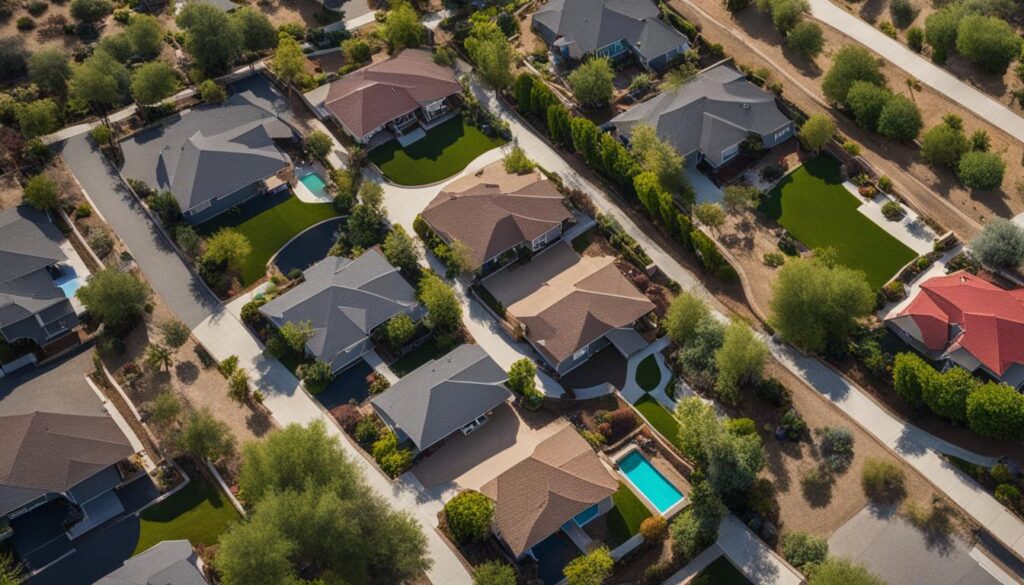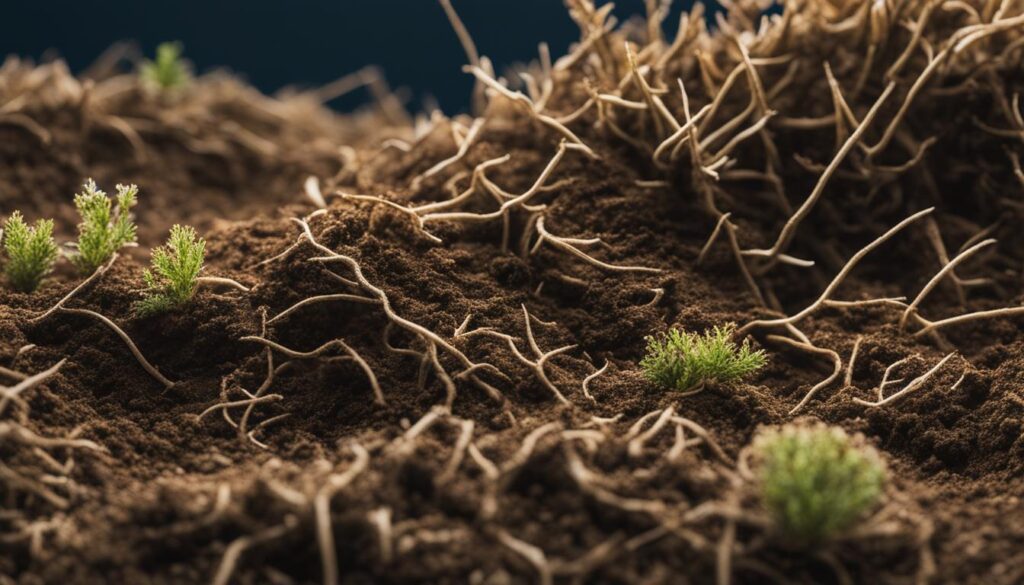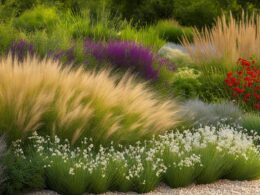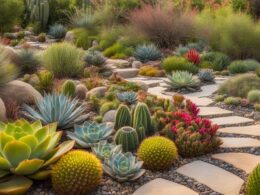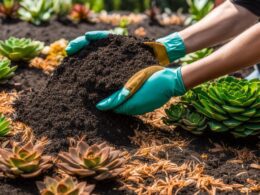Xeriscape zoning is a strategy that aims to conserve water in landscaping by using water-efficient plants and implementing efficient irrigation systems. By embracing xeriscape zoning techniques, you can not only create a beautiful landscape but also contribute to water conservation efforts. With more than 50% of summer domestic water use going towards outdoor watering, xeriscape zoning can significantly reduce or eliminate the need for potable water in landscape irrigation.
This concept, initially developed in Denver, CO, in response to water shortages, has gained popularity for its ability to create stunning landscapes while conserving water. By reducing the area under irrigation, using recycled or low-quality groundwater, implementing efficient irrigation systems, and selecting plants adapted to the local climate, xeriscape zoning minimizes water usage in landscapes.
If you’re looking to conserve water and create a sustainable landscape, xeriscape zoning is the way to go. Let’s explore the concept of xeriscape, its benefits, practical tips for implementation, and how to maintain a thriving xeriscape in the sections to follow.
Key Takeaways:
- Xeriscape zoning helps conserve water in landscaping.
- It reduces or eliminates the need for potable water in landscape irrigation.
- Xeriscape zoning can create beautiful landscapes while conserving water.
- Implementing xeriscape techniques reduces outdoor water usage by up to 75%.
- Xeriscaping promotes environmental sustainability and cost savings.
Continue reading the article to learn more about xeriscape zoning and how it can transform your landscape while conserving water.
The Concept of Xeriscape
The concept of xeriscape revolves around creating visually appealing landscapes that require minimal water usage. It is a landscaping practice that focuses on drought-tolerant plants and water-efficient techniques to conserve water resources. By implementing xeriscape principles, homeowners can create beautiful and sustainable gardens that are environmentally friendly.
The core idea behind xeriscape is to design landscapes that reduce the need for supplemental irrigation and minimize water waste. This is achieved by selecting plants that are adapted to local climate conditions and require less water to thrive. Drought-tolerant plants, along with appropriate soil preparation and mulching, help retain moisture in the soil, reducing the need for excessive watering.
“Xeriscape is not about sacrificing beauty; it’s about cultivating an aesthetically pleasing landscape while conserving water.”
In addition to plant selection, efficient irrigation systems such as drip irrigation can be implemented to deliver water directly to the roots, minimizing evaporation. By incorporating these techniques, homeowners can create landscapes that are not only visually appealing but also contribute to water conservation efforts.
| Xeriscape Principles | Description |
|---|---|
| Planning and Design | Strategically designing landscapes to optimize water usage and minimize water requirements. |
| Efficient Irrigation Systems | Implementing drip irrigation or other efficient irrigation methods to deliver water directly to plant roots. |
| Use of Mulch | Applying organic mulch to retain soil moisture, reduce evaporation, and suppress weed growth. |
| Soil Preparation | Preparing the soil with organic matter to improve water retention and drainage. |
| Appropriate Turf | Selecting grass varieties that are adapted to the local climate and require less water. |
| Water-Efficient Plant Material | Choosing drought-tolerant plants that thrive with minimal supplemental irrigation. |
| Appropriate Maintenance | Maintaining landscapes with efficient watering schedules, pruning, and weed control. |
Benefits of Xeriscape Zoning
Xeriscape zoning offers numerous benefits for homeowners, gardeners, and the environment. One of the main advantages is water conservation, as xeriscaping can reduce outdoor water usage by up to 75% compared to traditional landscapes. This is especially crucial in areas facing water scarcity or prone to drought.
Additionally, xeriscaping promotes environmental sustainability by minimizing water usage, reducing the need for chemical fertilizers and pesticides, and promoting a healthier ecosystem. By selecting drought-tolerant and native plants, xeriscapes can support local biodiversity and attract pollinators. The use of mulch in xeriscaping helps retain soil moisture, reduce evaporation, and suppress weed growth, further contributing to the sustainability of the landscape.
Another significant benefit of xeriscape zoning is cost savings. By reducing water usage, homeowners can expect lower water bills. Additionally, xeriscaping requires less maintenance and mowing, which can lead to savings in landscaping expenses. Moreover, xeriscaped landscapes are becoming increasingly desirable among homebuyers, potentially increasing property value.
In summary, xeriscape zoning not only conserves water and promotes environmental sustainability but also offers cost savings and enhances the visual appeal of landscapes. By embracing xeriscaping techniques, homeowners can create beautiful, water-efficient gardens while contributing to a greener future.
Practical Tips for Xeriscape Zoning
Implementing xeriscape zoning techniques can help you create an aesthetically pleasing and environmentally friendly garden. By following these practical tips, you can ensure the success of your xeriscape and maximize water efficiency.
Soil Preparation
Proper soil preparation is essential for a thriving xeriscape. Start by testing your soil composition and pH levels to determine its suitability for water retention. Amend the soil with organic matter, such as compost, to improve its water-holding capacity and drainage capabilities. This prepares a solid foundation for your plants and helps them thrive with less water.
Plant Selection
Choosing the right plants is crucial in xeriscape zoning. Opt for drought-tolerant and native plants that are well-adapted to your local climate. These plants require minimal supplemental irrigation and can thrive with natural rainfall. Group plants with similar water needs together to efficiently manage water usage. Embrace groundcovers and low-water turf alternatives to further reduce water requirements.
Efficient Irrigation
Implementing efficient irrigation practices is key to water-efficient gardening. Consider using drip irrigation systems that deliver water directly to the plant roots, minimizing water loss through evaporation. Time your irrigation during cooler hours to reduce evaporation, and consider rainwater harvesting techniques to further enhance water efficiency. Proper design of your irrigation system, based on the water needs of your plants, will ensure effective water distribution.
Additional Tips
- Consider hardscaping features, such as pathways and rock gardens, to reduce the area requiring irrigation.
- Apply mulch around plants to retain soil moisture and inhibit weed growth. Organic mulches like wood chips or straw are excellent choices.
- Regular maintenance, including pruning and monitoring irrigation, is crucial for the long-term success of your xeriscape. Stay attentive to the water and fertilizer needs of your plants.
By following these practical tips for xeriscape zoning, you can create a visually appealing, water-efficient garden that thrives in harmony with the environment.
Soil Analysis and Improvements in Xeriscape Zoning
One of the key components of successful xeriscape zoning is performing a thorough soil analysis and implementing necessary improvements. Understanding the characteristics of the soil in your landscape is essential for determining its water-holding capacity and nutrient requirements. By assessing the soil structure, texture, and chemical composition, you can make informed decisions about soil amendments and ensure optimal water retention for your xeriscape.
In order to improve the water retention capabilities of the soil, organic matter amendments, such as compost, can be introduced. These amendments enhance the soil’s ability to hold moisture and promote better drainage, creating a favorable environment for water-efficient plants. Additionally, proper slope and grading during landscape construction can help maximize soil moisture retention, preventing unnecessary water loss.
Performing a soil analysis and making necessary improvements ensures that your xeriscape is equipped with a well-prepared soil foundation. With better water retention and nutrient availability, the soil will support the growth and resilience of the carefully selected plants, making your xeriscape more sustainable and water-efficient.
Selecting Plants for Xeriscape Zoning
In xeriscape zoning, selecting the right plants is crucial for creating a water-efficient and visually appealing landscape. By choosing drought-tolerant plants that are well-suited to the local climate, you can minimize water usage and maintain the beauty of your garden. Native plants are particularly suitable for xeriscape zoning as they have adapted to the natural conditions and require less water for survival.
When selecting plants for xeriscape zoning, consider their water needs and compatibility with the local climate. Grouping plants with similar water requirements together can help manage water usage more efficiently. Incorporating groundcovers in your design can also provide additional benefits, such as reducing soil erosion and weed growth.
Benefits of Drought-Tolerant Plants in Xeriscape Zoning
- Drought-tolerant plants require less water, reducing overall water consumption.
- Native plants are adapted to the local climate, making them more resilient to drought conditions.
- Choosing drought-tolerant plants reduces the need for supplemental irrigation, saving time and resources.
- Drought-tolerant plants often have unique and attractive features, adding beauty and visual interest to your landscape.
To assist you in selecting the right plants for your xeriscape, consult local gardening resources, nurseries, or landscape professionals who are knowledgeable about the plants native to your region. They can provide guidance on suitable plant choices and help you create a xeriscape that thrives in your specific location.
| Plant | Water Requirements | Characteristics |
|---|---|---|
| Agave americana | Low | Succulent with striking architectural structure |
| Salvia leucantha | Low to Moderate | Attractive purple flowers that bloom in autumn |
| Yucca filamentosa | Low | Evergreen plant with sword-like leaves and tall flower spikes |
| Penstemon digitalis | Low to Moderate | Tall spikes of tubular flowers in various colors |
Remember, the key to successful xeriscape zoning is to choose plants that are adapted to your local climate and require minimal water. By selecting drought-tolerant and native plants, you can create a water-efficient landscape that thrives in harmony with its surroundings.
Efficient Irrigation in Xeriscape Zoning
Xeriscape zoning emphasizes the importance of efficient irrigation techniques to minimize water usage while maintaining healthy landscapes. One popular method is drip irrigation, which delivers water directly to the plant roots, reducing water loss through evaporation and ensuring precise water distribution. By implementing drip irrigation systems, you can optimize water efficiency and promote the growth of drought-tolerant plants in your xeriscape garden.
To make the most of drip irrigation, it’s essential to design the system according to the specific water needs of your plants. Grouping plants with similar water requirements together and separating water-use zones can help ensure efficient water distribution. Additionally, timing your irrigation during cooler hours and incorporating rainwater harvesting techniques can further maximize water conservation in your xeriscape garden.
Benefits of Drip Irrigation in Xeriscape Zoning
Drip irrigation offers several benefits in xeriscape zoning. Firstly, it reduces water waste by delivering water directly to the plants’ root zones, minimizing evaporation and runoff. This targeted approach promotes plant growth while conserving water. Secondly, drip irrigation can prevent weed growth by providing water only to the plants, reducing moisture availability for weeds. Thirdly, it allows for precise control over water distribution, ensuring that each plant receives the appropriate amount of water according to its needs.
Installation and Maintenance of Drip Irrigation Systems
Installing a drip irrigation system in your xeriscape garden requires careful planning and proper implementation. Start by creating a layout that includes the placement of irrigation lines and emitters based on the plant arrangement. Choose high-quality materials that are durable and resistant to clogging. Regular maintenance is essential to ensure optimal system performance. Inspect the system regularly for leaks, blockages, or damaged components, and make any necessary repairs or replacements.
| Key Points | Benefits |
|---|---|
| Targeted water delivery | Reduces water waste |
| Prevents weed growth | Preserves water for plants |
| Precise control over water distribution | Optimizes plant growth |
In conclusion, efficient irrigation techniques, such as drip irrigation, play a crucial role in xeriscape zoning. By implementing these methods, you can conserve water, promote the growth of water-efficient plants, and maintain a beautiful and sustainable xeriscape garden.
Using Mulch in Xeriscape Zoning
Mulching is an essential element of xeriscape zoning, providing numerous benefits for water retention and weed control. By applying mulch around plants, you can create a protective barrier that helps retain soil moisture and reduce evaporation. This is particularly important in arid climates where water conservation is crucial. Mulch also plays a vital role in inhibiting weed growth, minimizing competition for water and nutrients. Additionally, it adds organic matter to the soil, improving its overall health and fertility.
“Applying mulch around plants helps retain soil moisture, reduce evaporation, and inhibit weed growth.”
When selecting mulch for your xeriscape, it is important to choose materials that are suitable for water retention and weed control. Permeable organic mulches, such as wood chips, straw, or bark, allow water and oxygen to reach the plant roots effectively, while also preventing weed growth. Avoid using non-permeable materials like plastic or rubber, as they can hinder moisture absorption and lead to water runoff.
Proper application of mulch is also essential. Apply a layer of mulch that is 2-4 inches thick, ensuring that it covers the entire root zone of the plants. Take care to avoid piling mulch against the plant stems, as this can create a favorable environment for pests and diseases. Regularly inspect and replenish the mulch as needed, as it may break down over time.
Benefits of Mulching in Xeriscape Zoning:
- Retains soil moisture and reduces evaporation
- Inhibits weed growth and minimizes competition for water and nutrients
- Improves overall soil health and fertility
| Type of Mulch | Water Retention | Weed Control |
|---|---|---|
| Wood Chips | High | Effective |
| Straw | Medium | Good |
| Bark | High | Effective |
Maintenance in Xeriscape Zoning
Proper maintenance is essential for the long-term success of your xeriscape. By implementing effective water and fertilizer management techniques and practicing grasscycling, you can ensure the continued beauty and water efficiency of your landscape.
Water management is a key aspect of xeriscape maintenance. It’s important to monitor your irrigation system and adjust it according to the needs of your plants. Avoid over-watering, as it can lead to water waste and promote the growth of weeds. Regularly check for leaks and ensure that water is being distributed efficiently to minimize runoff and increase water conservation.
Fertilizer management is equally important in maintaining a healthy xeriscape. Use slow-release or organic fertilizers to provide nutrients to your plants without causing excessive growth or nutrient runoff. Follow the recommended application rates and timing for your specific plant types, and always read the fertilizer labels for guidance.
Grasscycling: A Sustainable Practice
Grasscycling is a sustainable lawn care practice that involves leaving grass clippings on your lawn after mowing. This simple technique can help reduce water usage and promote healthier grass growth. As the clippings decompose, they release nutrients back into the soil, acting as a natural fertilizer. Grasscycling also helps retain moisture in the soil, reducing the need for additional watering.
To effectively grasscycle, adjust your lawnmower to a higher cutting height. This allows the grass clippings to remain on the lawn without smothering the grass. It’s important to mow the lawn regularly and avoid cutting more than one-third of the grass height at a time. By implementing grasscycling in your xeriscape, you can contribute to water conservation efforts and maintain a vibrant, healthy lawn.
Xeriscape Maintenance Checklist
Here’s a checklist to help you stay on top of xeriscape maintenance:
- Regularly monitor and adjust your irrigation system to ensure efficient water distribution.
- Check for leaks or issues with your irrigation system to prevent water waste.
- Practice proper water and fertilizer management to avoid over-watering and nutrient runoff.
- Consider using slow-release or organic fertilizers to provide nutrients to your plants without causing excessive growth.
- Implement grasscycling by leaving grass clippings on your lawn after mowing to promote healthier grass growth and reduce water usage.
- Regularly prune and weed your xeriscape to maintain its overall health and appearance.
By following these maintenance tips and practices, you can ensure that your xeriscape remains beautiful, water-efficient, and environmentally sustainable for years to come.
Conclusion
Water-wise landscaping is more important than ever in creating sustainable gardens. Xeriscape zoning offers numerous benefits, allowing you to conserve water while still creating beautiful landscapes. By implementing the principles of xeriscape, you can contribute to the preservation of water resources and enjoy long-term cost savings.
With its focus on drought-tolerant plants, efficient irrigation, mulching, and proper maintenance, xeriscape zoning is the key to a thriving and water-efficient garden. By selecting plants that are well-suited to your local climate, you can significantly reduce water usage and create a visually appealing landscape.
Xeriscape zoning also promotes environmental sustainability by minimizing water consumption, reducing the need for harmful chemicals, and supporting a healthier ecosystem. In addition, it can increase the value of your property, as more homebuyers are looking for water-efficient landscapes.
Embrace the principles of xeriscape zoning and make a difference in conserving water resources. Create a greener future with sustainable gardens that not only beautify your surroundings but also contribute to a more sustainable and water-wise world.
What Are the Most Efficient Zoning Techniques for Xeriscaping Irrigation Systems?
When considering xeriscaping irrigation installation tips, it’s important to maximize efficiency. Utilizing zoning techniques such as drip irrigation and separating plants with similar water needs into designated zones can help conserve water and promote healthier growth in xeriscaping landscapes. Proper zoning can minimize water waste and reduce maintenance requirements.
FAQ
What is xeriscape zoning?
Xeriscape zoning is a strategy that aims to conserve water in landscaping by using water-efficient plants and implementing efficient irrigation systems.
How does xeriscape zoning conserve water?
Xeriscape zoning conserves water by reducing the area under irrigation, using recycled or low-quality groundwater, using efficient irrigation systems, and selecting plants that require less water.
Where was xeriscape zoning developed?
Xeriscape zoning was developed in Denver, CO, as a response to water shortages.
What are the benefits of xeriscape zoning?
Xeriscape zoning offers benefits such as water conservation, environmental sustainability, cost savings, and increased property value.
What are some practical tips for successful xeriscape zoning?
Some practical tips for successful xeriscape zoning include proper soil preparation, plant selection, efficient irrigation, and mulching.
Why is soil analysis important in xeriscape zoning?
Soil analysis helps determine soil composition, water-holding capacity, and nutrient requirements, ensuring that the soil is well-prepared to support water-efficient plants.
What types of plants should be selected for xeriscape zoning?
Drought-tolerant and native plants that are well-suited to the local climate and require less water should be selected for xeriscape zoning.
What is efficient irrigation in xeriscape zoning?
Efficient irrigation in xeriscape zoning includes the use of drip irrigation systems, timing irrigation during cooler hours, and incorporating rainwater harvesting techniques.
How does mulching contribute to xeriscape zoning?
Mulching helps retain soil moisture, reduce evaporation, inhibit weed growth, add organic matter to the soil, and moderate soil temperatures in xeriscape zoning.
What is the importance of maintenance in xeriscape zoning?
Proper maintenance, including water and fertilizer management, pruning, weeding, and grasscycling, is essential for the long-term success of a xeriscape.








